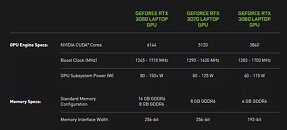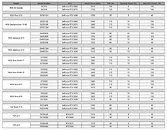Raevenlord
News Editor
- Joined
- Aug 12, 2016
- Messages
- 3,755 (1.25/day)
- Location
- Portugal
| System Name | The Ryzening |
|---|---|
| Processor | AMD Ryzen 9 5900X |
| Motherboard | MSI X570 MAG TOMAHAWK |
| Cooling | Lian Li Galahad 360mm AIO |
| Memory | 32 GB G.Skill Trident Z F4-3733 (4x 8 GB) |
| Video Card(s) | Gigabyte RTX 3070 Ti |
| Storage | Boot: Transcend MTE220S 2TB, Kintson A2000 1TB, Seagate Firewolf Pro 14 TB |
| Display(s) | Acer Nitro VG270UP (1440p 144 Hz IPS) |
| Case | Lian Li O11DX Dynamic White |
| Audio Device(s) | iFi Audio Zen DAC |
| Power Supply | Seasonic Focus+ 750 W |
| Mouse | Cooler Master Masterkeys Lite L |
| Keyboard | Cooler Master Masterkeys Lite L |
| Software | Windows 10 x64 |
It seemed has if NVIDIA was dropping the Max-P and Max-Q differentiators for their mobile graphics card, which would throw consumers into disarray and confusion as to what exactly was the performance of the graphics card built into their RTX 30-series laptop. In essence, due to the RTX 30-series configurable TGP (Total Graphics Power), as well as each laptop's own capability of supplying power and cooling to that chip, users might see themselves in situations such as their mobile RTX 3080 offering lower performance than a mobile RTX 3070, configured for a higher TGP. This meant that more attentive users would have to hunt for reviews of the laptops they were eyeing, or to be forced to count on system manufacturers to actually list specifications for the included graphics solution in their laptops. This would mean, more often than not, something akin to chaos, and could in truth impact NVIDIA's brand recognition and consumer confidence in expected performance.
NVIDIA, as a way to circumvent this, has decided to not only encourage, but actually require that manufacturers list their graphics cards' TGP as well as specific clock speed stats on their online product pages. Some manufacturers, such as Asus, Acer, Razer, Origin, MSI, Alienware, and Gigabyte have already updated some product pages - but not all. An NVIDIA spokesperson clarified to The Verge that "We're requiring OEMs to update their product pages to the Max-Q technology features for each GeForce laptop, as well as clocks and power — which communicates the expected GPU performance in that system." Perhaps that will help consumers make a more informed decision.



View at TechPowerUp Main Site
NVIDIA, as a way to circumvent this, has decided to not only encourage, but actually require that manufacturers list their graphics cards' TGP as well as specific clock speed stats on their online product pages. Some manufacturers, such as Asus, Acer, Razer, Origin, MSI, Alienware, and Gigabyte have already updated some product pages - but not all. An NVIDIA spokesperson clarified to The Verge that "We're requiring OEMs to update their product pages to the Max-Q technology features for each GeForce laptop, as well as clocks and power — which communicates the expected GPU performance in that system." Perhaps that will help consumers make a more informed decision.



View at TechPowerUp Main Site







